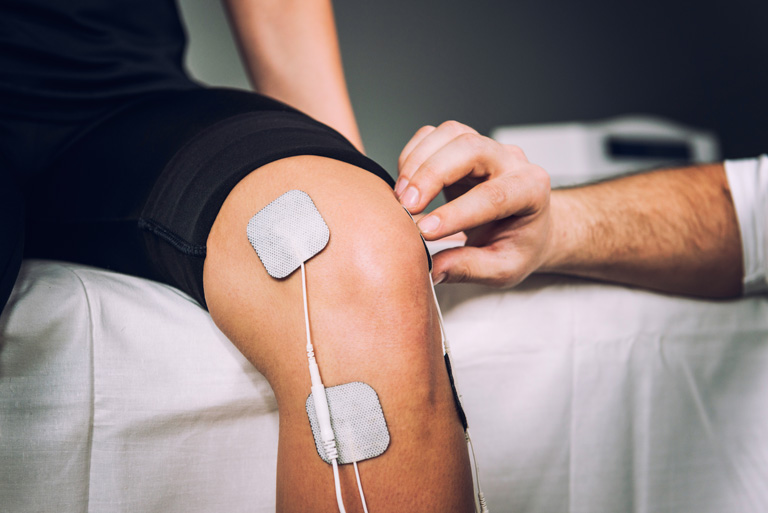
A commonly used technique to test the function of nerves and muscles is referred to as electrodiagnostic testing. This type of study is often ordered by a physician to find the cause or root of back or neck pain, numbness, tingling or loss of strength. From this study, a diagnosis can be made such as “pinched nerves” (radiculopathies), peripheral nerve injuries, compression neuropathies and muscle disease.
The body is an electrical generator. Within the human body, nerves and muscles create electrical signals delivering messages to and from the brain. The sensory nerves pass information about surroundings to the brain. Next, motor nerves send signals from the brain to the muscles. When these nerves are injured or diseased, the electrical signals can be slowed or completely stopped. By measuring the speed and degree of the electrical activity in the muscles and nerves, it will help to provide a proper diagnosis and a proper treatment plan.
Many people suffer from chronic pain because of injured or disease ridden nerves. Getting the right treatment plan will work to eliminate pain and focus on strength and recovery. Electrodiagnostic testing is the first step towards reduced nerve pain.
The Electromyogram
There are two parts to electrodiagnostic testing. The first is called the electromyogram. This part of the testing evaluates and records the electrical activity produced by skeletal muscles. The signals that are given off when these muscles are tested are used to determine if there are medical abnormalities.
How does an electromyogram work?
Small, thin needles will be placed in the arms, legs, and back directly. The electrical activity caused by the muscle contraction can then be evaluated. Most patients report that the needle feels like a small cramp in the muscle. Some soreness and bruising may occur, but there are no long term side effects.
The Nerve Conduction Study
The second part is a nerve conduction study. This test will be used to evaluate the ability of electrical conduction within the motor and sensory nerves of the body. The doctor will be able to see how fast or slow these nerves are functioning. Nerve conduction studies can show where a nerve is affected in the limb and how severely. Combining these two tests will measure the nerve functionality to work towards a diagnosis. This can be instrumental when working on a treatment plan for chronic pain.

How does this test work?
A doctor will begin the test by placing sensors over nerves in the arms and legs. These nerves will be electrically stimulated through the sensor. While some patients report the sensation as uncomfortable, it is usually not painful.
Overall Testing
Electrodiagnostic testing can prove peripheral nerve compression, at the wrist or elbow for instance, or nerve root irritation in the spine. The electromyogram helps determine if the nerve root is affected when the MRI is equivocal or shows which nerve root is more affected if imaging shows multiple abnormalities. It can also show that pain in the limb is not of spinal origin and treatments should be directed elsewhere.
It can also be especially helpful when determining pain felt in the arm, wrist or elbow. Electrodiagnostic testing can diagnose conditions called “compressive neuropathies.” These may include conditions such as:
- Carpal tunnel syndrome
- Thoracic outlet syndrome
- Ulnar nerve entrapment
- Cervical or lumbar radiculopathy.
Usually, testing will be done before a surgery is even considered. Oftentimes, electrodiagnostic testing can used to determine the extent of the injury or to study the effects of diseases, such as diabetes, that are known to affect nerves. Also, it can help to determine if a nerve is healing.
Who can perform Electrodiagnostic Testing?
Electrodiagnostic testing is taught to physiatrists (a rehabilitation medicine specialist) and neurologists in their training programs, but not anesthesiologists. The understanding of physiology, anatomy, and neuromuscular function that is needed for electrodiagnostic training is the backbone of any successful treatment program, because a correct diagnosis is where it all starts.
How accurate is Electrodiagnostic Testing?
The accuracy of electrodiagnostic testing is generally good. The test will be dependent on the ability of the person conducting the test and the equipment being used. Injuries to nerves or nerve roots and diseases of the nerves and muscles are generally diagnosed correctly. Be aware that nerves do heal slowly, so changes may take several weeks to notice a change.
Lastly, the existence or extent of pain cannot be determined using electrodiagnostic testing. The test may show that nerves are functioning normally, even if a patient is still in pain. In this case, treatment still can be determined.
In the end, most people suffering from nerve pain need a diagnosis before treatment can even be considered. Electrodiagnostic testing is the first step towards the diagnosis to create the right treatment plan. While parts of the testing might be uncomfortable, the overall test is painless.
Comments are closed.
